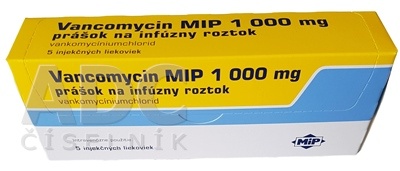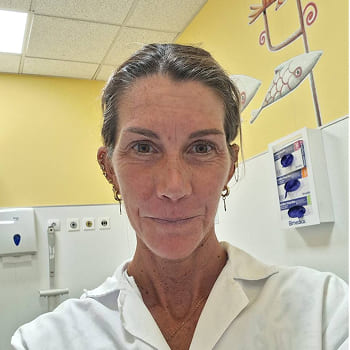

Vancomicin-mip 1000

Ask a doctor about a prescription for Vancomicin-mip 1000

How to use Vancomicin-mip 1000
Package Leaflet: Information for the Patient
Vancomycin–MIP 500, 500 mg, Powder for Solution for Infusion and Oral Solution
Oral
Vancomycin–MIP 1000, 1 g, Powder for Solution for Infusion and Oral Solution
Vancomycin
Read the package leaflet carefully before using the medicine, as it contains important information for the patient.
- Keep this package leaflet, you may need to read it again.
- In case of any doubts, consult a doctor or pharmacist.
- This medicine has been prescribed specifically for you. Do not pass it on to others. The medicine may harm another person, even if their symptoms are the same.
- If the patient experiences any side effects, including any not listed in this leaflet, they should inform their doctor or pharmacist. See section 4.
Table of Contents of the Package Leaflet
- 1. What is Vancomycin-MIP and what is it used for
- 2. Important information before using Vancomycin-MIP
- 3. How to use Vancomycin-MIP
- 4. Possible side effects
- 5. How to store Vancomycin-MIP
- 6. Contents of the pack and other information
1. What is Vancomycin-MIP and what is it used for
Vancomycin is an antibiotic belonging to the class of glycopeptide antibiotics. The action of vancomycin involves killing certain bacteria that cause infections. Vancomycin in powder form is used to prepare a solution for infusion or an oral solution.
Indications for Use
Intravenous administration Vancomycin is used in all age groups in the form of an infusion (drip) to treat the following severe infections:
- skin and subcutaneous tissue infections;
- bone and joint infections;
- lung infections, known as pneumonia;
- infections of the inner lining of the heart (endocarditis);
- blood infections related to the above infections. Oral administration Vancomycin may be given orally to adults and children to treat infections of the mucous membrane of the small and large intestine associated with damage to the mucous membrane (pseudomembranous colitis), caused by bacteria Clostridium difficile.
2. Important Information Before Using Vancomycin-MIP
When Not to Use Vancomycin-MIP
- if the patient is allergic to vancomycin or any of the other ingredients of this medicine (listed in section 6).
Warnings and Precautions
After injecting vancomycin into the eye, severe side effects have occurred, which can lead to vision loss. Before starting treatment with Vancomycin-MIP, the patient should discuss the following with their doctor, hospital pharmacist, or nurse:
- if the patient has previously had an allergic reaction to teicoplanin, as this may indicate that the patient is also allergic to vancomycin.
- if the patient has hearing problems, especially if they are elderly (hearing tests may be necessary during treatment).
- if the patient has kidney problems (blood tests and liver and kidney function tests may be necessary during treatment).
- if the patient is receiving vancomycin by infusion to treat diarrhea associated with Clostridium difficileinfection, instead of taking it orally.
- if the patient has ever had a severe skin rash or peeling of the skin, blisters, and (or) ulcers of the mouth after taking vancomycin. Severe skin reactions have occurred with vancomycin, including Stevens-Johnson syndrome, toxic epidermal necrolysis, drug reaction with eosinophilia and systemic symptoms (DRESS), and acute generalized exanthematous pustulosis (AGEP). If the patient notices any of the symptoms described in section 4, they should stop taking vancomycin and consult their doctor immediately. During treatment with Vancomycin-MIP, the patient should discuss the following with their doctor, hospital pharmacist, or nurse:
- if the patient is taking vancomycin for a long time (blood tests and liver and kidney function tests may be necessary during treatment).
- if the patient experiences any skin reaction during treatment.
- if the patient experiences severe or prolonged diarrhea during or after treatment with vancomycin; in such cases, they should consult their doctor immediately. This may be a sign of colitis (pseudomembranous colitis), which can occur during antibiotic treatment.
Children
Vancomycin will be used with caution in premature infants and young infants, as their kidneys are not fully developed, which can lead to the accumulation of vancomycin in the blood. In this age group, blood tests may be necessary to monitor the concentration of vancomycin in the blood. The simultaneous administration of vancomycin and anesthetics in children is associated with the occurrence of skin redness (flushing) and allergic reactions. Additionally, the simultaneous use of other medicines, such as aminoglycoside antibiotics, non-steroidal anti-inflammatory drugs (NSAIDs, e.g., ibuprofen), or amphotericin B (an antifungal medicine), may increase the risk of kidney damage, and therefore, more frequent blood tests and kidney function tests may be necessary.
Vancomycin-MIP and Other Medicines
The patient should tell their doctor or pharmacist about all medicines they are currently taking or have recently taken, as well as any medicines they plan to take. The patient should be cautious if they are taking other medicines that may interact with vancomycin, such as:
- nephrotoxic (kidney-damaging) medicines (e.g., piperacillin/tazobactam) and ototoxic (hearing-damaging) medicines - may enhance each other's side effects; special caution is necessary when using aminoglycosides simultaneously with vancomycin or immediately after it;
- anesthetics - may increase the risk of blood pressure drop, skin redness, flushing, hives, and itching (see section 4. Possible side effects);
- muscle relaxants - vancomycin may enhance and prolong the effects of muscle relaxants used during surgery, e.g., succinylcholine (neuromuscular blockade).
Use in Elderly Patients
The natural decline in glomerular filtration rate that occurs with age may lead to increased vancomycin concentrations in the blood if the dose is not properly adjusted (see "Dosage in patients with renal impairment").
Pregnancy and Breastfeeding
If the patient is pregnant or breastfeeding, thinks they may be pregnant, or plans to have a child, they should consult their doctor or pharmacist before using this medicine. There is limited experience with the use of vancomycin during pregnancy and breastfeeding in humans. Vancomycin can be given to pregnant women only when the benefit to the mother outweighs the potential risk to the fetus. Animal studies have not shown any effect on fetal development. Vancomycin passes into human milk, and therefore, breastfeeding should be discontinued during treatment with this medicine, as the child may experience side effects.
Driving and Using Machines
There are no data available.
3. How to Use Vancomycin-MIP
The patient will receive Vancomycin-MIP administered by medical staff during their hospital stay. The doctor will decide what dose of the medicine the patient should receive each day and how long the treatment should last.
Dosage
The dose administered will depend on:
- the patient's age,
- the patient's body weight,
- the type of infection,
- kidney function,
- the patient's hearing,
- any other medicines the patient is taking.
Intravenous Administration
Adults and Adolescents (12 years and older)
The dosage will be determined based on the patient's body weight. The usual dose used in infusion is 15 to 20 mg per kilogram of body weight. This dose is usually given every 8 to 12 hours. In some cases, the doctor may decide to use a loading dose of 30 mg per kilogram of body weight. The maximum daily dose should not exceed 2 grams.
Use in Children
Children from the first month of life and children under 12 years
The dosage will be determined based on the patient's body weight. The usual dose used in infusion is 10 to 15 mg per kilogram of body weight. This dose is usually given every 6 hours.
Preterm and full-term newborns (from birth to 27 days of postnatal age)
The dose will be calculated based on postconceptional age [the time from the first day of the last menstrual period to birth (gestational age) plus the time from birth (postnatal age)].
Oral Administration
Adults and Adolescents (12 to 18 years)
The recommended dose is 125 mg every 6 hours. In some cases, the doctor may decide to use a higher daily dose, up to a maximum of 500 mg every 6 hours. The maximum daily dose should not exceed 2 grams.
If the patient has had other disorders (mucous membrane infection), a different dose and duration of treatment may be necessary.
Use in Children
Newborns, infants, and children under 12 years
The recommended dose is 10 mg per kilogram of body weight. This dose is usually given every 6 hours. The maximum daily dose should not exceed 2 grams.
Method of Administration
Intravenous infusion (drip) means that the medicine flows from a bottle or infusion bag through a tube into one of the patient's veins. The doctor or nurse will always administer vancomycin into the blood, not into a muscle. Vancomycin will be administered into a vein over at least 60 minutes.
Oral administration method
If used to treat gastrointestinal disorders (pseudomembranous colitis), the medicine must be given as an oral solution (the patient will take the medicine orally).
The contents of one vial of Vancomycin-MIP 500 should be dissolved in 10 ml of water, and the contents of one vial of Vancomycin-MIP 1000 should be dissolved in 20 ml of water. Single doses can be drawn (e.g., 2.5 ml = 125 mg of vancomycin) and given to the patient to drink in a slightly diluted form or introduced through a gastric tube. A flavoring agent, such as a commonly used syrup, can be added to the prepared solution.
Intravenous administration method
Detailed instructions are provided at the end of the package leaflet, in the section "Information intended for healthcare professionals only".
Duration of Treatment
The duration of treatment depends on the type of infection the patient has and may last for several weeks.
The duration of treatment may vary depending on the patient's response to treatment. During treatment, the patient may undergo blood tests and urine analysis, and may also have a hearing test to check for possible side effects.
Overdose of Vancomycin-MIP
Treatment used in case of overdose:
- a specific antidote is not known;
- high concentrations of vancomycin in the blood can be effectively reduced using hemodialysis with polysulfone membranes, as well as hemofiltration or hemoperfusion with polysulfone resins;
- in case of overdose, symptomatic treatment and maintenance of kidney function are necessary. If a higher dose of the medicine is taken, the patient should immediately consult a doctor or pharmacist.
Missed Dose of Vancomycin-MIP
The patient should not take a double dose to make up for a missed dose.
4. Possible Side Effects
Like all medicines, this medicine can cause side effects, although not everybody gets them.
If the patient notices any of the following symptoms, they should stop taking vancomycin and consult their doctor immediately:
- red, flat, target-like or circular patches on the torso, often with blisters in the center, peeling of the skin, ulcers of the mouth, throat, nose, genitals, and eyes. The occurrence of these severe skin rashes may be preceded by fever and flu-like symptoms (Stevens-Johnson syndrome and toxic epidermal necrolysis).
- widespread rash, high fever, and swollen lymph nodes (DRESS or drug reaction with eosinophilia and systemic symptoms).
- red, peeling rash with bumps under the skin and blisters, accompanied by fever, usually at the beginning of treatment (acute generalized exanthematous pustulosis).
Vancomycin may cause allergic reactions, but severe allergic reactions (anaphylactic reactions) are rare. If the patient suddenly experiences wheezing, difficulty breathing, redness of the upper body, rash, or itching, they should immediately
inform their doctor.
Vancomycin is poorly absorbed from the gastrointestinal tract. However, if the patient has an inflammatory gastrointestinal disease, and especially if they also have kidney problems, side effects similar to those that occur after intravenous administration of vancomycin may occur (see section 4.4).
Common Side Effects (may affect up to 1 in 10 people):
- Low blood pressure,
- Shortness of breath, wheezing (high-pitched sound caused by obstruction of air flow in the upper airways),
- Rash and inflammation of the mucous membrane of the mouth, itching, itchy rash, hives,
- Kidney problems, usually detected in blood tests,
- Redness of the upper body and face, vein inflammation.
Uncommon Side Effects (may affect up to 1 in 100 people):
- Temporary or permanent hearing loss
Rare Side Effects (may affect up to 1 in 1,000 people)
- Decrease in the number of white blood cells, red blood cells, and platelets (blood cells responsible for blood clotting), increase in the number of certain white blood cells in the blood,
- Balance disorders, ringing in the ears, dizziness,
- Vasculitis (inflammation of blood vessels),
- Nausea (nausea),
- Kidney inflammation and kidney failure,
- Chest and back muscle pain,
- Fever, chills.
Very Rare Side Effects (may affect up to 1 in 10,000 people)
- Sudden onset of a severe allergic skin reaction, including peeling of the skin or blistering. This may be accompanied by high fever and joint pain.
- Cardiac arrest,
- Intestinal inflammation causing abdominal pain and diarrhea, which may contain blood.
Frequency Not Known (frequency cannot be estimated from the available data):
- Vomiting, diarrhea,
- Confusion, drowsiness, lack of energy, swelling, fluid retention, decreased urine production.
- Rash with swelling and pain in the area behind the ears, neck, armpits, under the chin and under the arms (lymph node swelling), abnormal blood test results and liver function tests,
- Rash with blisters and fever.
Reporting Side Effects
If the patient experiences any side effects, including any possible side effects not listed in this leaflet, they should inform their doctor or hospital pharmacist or nurse. Side effects can be reported directly to the Department of Drug Safety Monitoring of the Office for Registration of Medicinal Products, Medical Devices, and Biocidal Products
Al. Jerozolimskie 181C, 02-222 Warsaw
Phone: +48 22 49 21 301
Fax: +48 22 49 21 309
Website: https://smz.ezdrowie.gov.pl
Side effects can also be reported to the marketing authorization holder.
By reporting side effects, more information can be collected on the safety of this medicine.
5. How to Store Vancomycin-MIP
Keep the medicine out of the sight and reach of children.
Do not use this medicine after the expiry date stated on the carton after "Expiry date". The expiry date refers to the last day of the month.
Store in a temperature below 25°C, protected from light.
Shelf life of the oral solution
The prepared oral solution can be stored for 96 hours at a temperature of 2°C-8°C.
Shelf life of the infusion solution
The prepared infusion solution remains stable for 24 hours in the refrigerator, i.e., at a temperature of 2°C-8°C. The infusion solution should be used immediately after preparation.
Medicines should not be disposed of via wastewater or household waste. The patient should ask their pharmacist how to dispose of medicines that are no longer needed. This will help protect the environment.
6. Contents of the Pack and Other Information
What Vancomycin-MIP Contains
- The active substance of the medicine is vancomycin. Vancomycin-MIP 500: 1 vial contains 500 mg of vancomycin (in the form of 510 mg of vancomycin hydrochloride), which corresponds to 500,000 IU of vancomycin. Vancomycin-MIP 1000: 1 vial contains 1 g of vancomycin (in the form of 1020 mg of vancomycin hydrochloride), which corresponds to 1,000,000 IU of vancomycin. The medicine does not contain any other ingredients.
What Vancomycin-MIP Looks Like and Contents of the Pack
Depending on the crystal structure of the active substance, the lyophilizate may have a color from white to slightly pink or even brown.
Vancomycin-MIP 500: vials made of colorless glass, sealed with a stopper and aluminum cap, in a cardboard box containing 1 vial or 5 vials.
Vancomycin-MIP 1000: vials made of colorless glass, sealed with a stopper and aluminum cap, in a cardboard box containing 1 vial or 5 vials.
Not all pack sizes may be marketed.
Marketing Authorization Holder
MIP Pharma Polska Sp. z o.o.
ul. Orzechowa 5
80-175 Gdańsk
phone: 58 303 93 62
fax: 58 322 16 13
e-mail: [email protected]
Manufacturer
Chephasaar, Chemisch-pharmazeutische Fabrik GmbH
Mühlstrasse 50
D-66386 St. Ingbert
Germany
Date of Last Revision of the Package Leaflet:
Other Sources of Information
Detailed information about this medicine is available on the website of the Office for Registration of Medicinal Products, Medical Devices, and Biocidal Products.
www.urpl.gov.pl
Medical Advice and Education
Antibiotics are used to treat bacterial infections. They are ineffective against viral infections.
If a doctor has prescribed antibiotics to the patient, they are necessary to treat a specific, current illness.
Despite the use of antibiotics, some bacteria may survive or continue to multiply. This phenomenon is called resistance; it can make antibiotic treatment ineffective.
Improper use of antibiotics promotes the development of resistance. The patient can also facilitate the development of resistance and thus delay recovery or reduce the effectiveness of antibiotic therapy if they do not follow the proper:
- dosing,
- treatment schedule,
- duration of treatment. To maintain the effectiveness of this medicine, the patient should:
- 1 - use antibiotics only when prescribed by a doctor.
- 2 - strictly follow the prescribed method of administration.
- 3 - not use antibiotics again without the doctor's recommendation, even to treat a similar illness.
Information Intended for Healthcare Professionals Only
Refer to the current full product information contained in the Summary of Product Characteristics (SmPC) available on the website of the Office for Registration of Medicinal Products, Medical Devices, and Biocidal Products.
Spectrum of antibacterial activity
Vancomycin is active against Gram-positive bacteria, such as staphylococci, streptococci, enterococci, pneumococci, and Clostridium. Gram-negative bacteria are resistant.
In some cases, an increasing number of resistance cases are observed, especially among enterococci; the occurrence of multi-drug resistant Enterococcus faeciumstrains is particularly concerning.
Cross-resistance with other glycopeptide antibiotics, such as teicoplanin, occurs.
It is recommended to take samples for bacterial culture to isolate and identify the causative microorganisms and determine their susceptibility to vancomycin.
Dosage
In appropriate cases, vancomycin should be used in combination with other antibacterial products.
Intravenous Administration
The initial dose should be determined based on the total body weight. Subsequent modifications of the dose should be based on the concentration of vancomycin in the serum, with the aim of achieving the target therapeutic concentration. When determining subsequent doses and intervals between them, kidney function should also be taken into account.
Patients 12 years and older
The recommended dose is 15 to 20 mg/kg every 8 to 12 hours (do not exceed 2 grams per dose).
In critically ill patients, a loading dose of 25-30 mg/kg may be used to rapidly achieve the target minimum concentration of vancomycin in the serum.
Newborns from the first month of life and children under 12 years:
The recommended dose is 10 to 15 mg/kg every 6 hours (see section 4.4 of the SmPC).
Full-term newborns (from birth to 27 days of postnatal age) and preterm infants (from birth to the expected date of delivery plus 27 days)
To determine the dosing regimen for newborns, consult a doctor experienced in the treatment of newborns. One possible dosing regimen for vancomycin in newborns is presented in the table below (see section 4.4 of the SmPC):
| PMA (weeks) | Dose (mg/kg) | Interval between doses (hours) |
| <29 | 15 | 24 |
| 29-35 | 15 | 12 |
| >35 | 15 | 8 |
PMA: postconceptional age [time from the first day of the last menstrual period to birth (gestational age) plus time from birth (postnatal age)].
Duration of Treatment
The recommended duration of treatment is given in the table below. In each case, the duration of treatment should be adjusted according to the type and severity of the infection and the individual clinical response.
| Indication | Duration of Treatment |
Complicated skin and soft tissue infections
| 7 to 14 days 4 to 6 weeks* |
| Bone and joint infections | 4 to 6 weeks** |
| Community-acquired pneumonia | 7 to 14 days |
| Hospital-acquired pneumonia, including ventilator-associated pneumonia | 7 to 14 days |
| Infective endocarditis | 4 to 6 weeks*** |
* Continue until it is no longer necessary to remove necrotic tissue, the patient's clinical condition improves, and the patient has not had a fever for 48-72 hours.
** In the case of prosthetic joint infections, consider longer cycles of oral suppressive therapy with appropriate antibiotics for prosthetic joint infections.
*** The duration and need for combination therapy depend on the type of valve and microorganism.
Special Patient Groups
Elderly Patients
Due to the age-related decline in glomerular filtration rate, it may be necessary to use lower maintenance doses.
Patients with Renal Impairment
In adult and pediatric patients with renal impairment, the initial loading dose should be considered, and subsequent doses should be based on the concentration of vancomycin in the serum, rather than the planned dosing regimen, especially in patients with severe renal impairment or those undergoing renal replacement therapy (RRT), due to the many variables that affect vancomycin concentrations in such patients.
Patients with mild or moderate renal impairment should not have their initial dose reduced. In patients with severe renal impairment, it is preferable to extend the intervals between doses rather than administer lower doses.
It is necessary to properly evaluate concomitantly administered medicines that may decrease vancomycin clearance and (or) enhance its side effects (see section 4.4 of the SmPC).
Vancomycin is poorly removed by intermittent hemodialysis. However, the use of high-flux dialysis membranes or continuous renal replacement therapy (CRRT) increases vancomycin clearance, and it is generally necessary to administer supplemental doses (usually after a hemodialysis session, in the case of intermittent hemodialysis).
Adult Patients
Dose modifications in adult patients may be based on the estimated glomerular filtration rate (eGFR) using the following formula:
Men: [Weight (kg) x 140 - age (years)] / 72 x serum creatinine concentration (mg/dl)
Women: 0.85 x the value calculated using the above formula.
Usual initial dose for adult patients is 15 to 20 mg/kg; this dose can be administered every 24 hours to patients with a creatinine clearance of 20 to 49 ml/min. In patients with severe renal impairment (creatinine clearance below 20 ml/min) or those undergoing renal replacement therapy, the appropriate intervals between doses and the size of subsequent doses largely depend on the RRT method used and should be determined based on the vancomycin concentration in the serum before administration and residual renal function (see section 4.4 of the SmPC). Depending on the clinical situation, it may be necessary to withhold the next dose until the vancomycin concentration in the blood is determined.
Patients with Hepatic Impairment
There is no need to adjust the dose in patients with mild hepatic impairment.
Pregnancy
| GFR (mL/min/1.73 m2) | Intravenous Dose | Frequency |
| 50-30 | 15 mg/kg | Every 12 hours |
| 29-10 | 15 mg/kg | Every 24 hours |
| <10 | 10-15 mg/kg | Repeat dose depending on concentration* |
| Intermittent hemodialysis | ||
| Peritoneal dialysis | ||
| Continuous renal replacement therapy | 15 mg/kg | Repeat dose depending on concentration* |
In pregnant women, it may be necessary to significantly increase the dose to achieve therapeutic serum concentrations (see section 4.6 of the SmPC).
Obese Patients
In obese patients, the initial dose should be adjusted individually based on total body weight, as for patients with normal body weight.
Oral Administration
Patients 12 years and older
Treatment of Clostridium difficileinfection (CDI).
The recommended dose of vancomycin is 125 mg every 6 hours for 10 days in the case of the first episode of non-severe CDI. The dose may be increased to 500 mg every 6 hours for 10 days in the case of severe or complicated disease. The maximum daily dose should not exceed 2 grams.
In patients with multiple recurrences, it may be necessary to treat the current episode of CDI with vancomycin at a dose of 125 mg four times a day for 10 days, followed by a gradual reduction in dose to 125 mg per day or the use of a pulsing regimen, i.e., 125-500 mg/day every 2-3 days for at least 3 weeks.
Newborns, infants, and children under 12 years
The recommended dose of vancomycin is 10 mg/kg every 6 hours for 10 days. The maximum daily dose should not exceed 2 grams.
The duration of treatment with vancomycin may need to be adjusted according to the clinical course of the disease in each case. Whenever possible, the use of the antibacterial product suspected of causing CDI should be discontinued. It is necessary to ensure adequate fluid and electrolyte replacement.
Monitoring of Vancomycin Concentration in Serum
The frequency of therapeutic drug monitoring (TDM) should be adjusted individually according to the clinical situation and response to treatment; the frequency of sampling may range from daily in some unstable hemodynamic patients to once a week in stable patients with a visible response to treatment. In patients with normal renal function, the concentration of vancomycin in the serum should be determined on the second day of treatment, immediately before the next dose.
In patients undergoing intermittent hemodialysis, the concentration of vancomycin should be determined before the start of the hemodialysis session.
Monitoring of vancomycin concentration in the serum after oral administration should be performed in patients with inflammatory gastrointestinal diseases (see section 4.4 of the SmPC).
The minimum therapeutic concentration of vancomycin in the blood should be 10-20 mg/l, depending on the site of infection and the susceptibility of the pathogen. Clinical laboratories usually recommend a minimum concentration of 15-20 mg/l, ensuring better coverage of microorganisms classified as susceptible with an MIC ≥1 mg/l (see sections 4.4 and 5.1 of the SmPC).
In predicting individual dosing required to achieve the appropriate AUC value, model-based methods may be useful. A model-based approach can be used to calculate the individual initial dose and to modify doses based on TDM results (see section 5.1 of the SmPC).
Method of Administration
Intravenous Administration
Vancomycin is usually administered intravenously in the form of an intermittent infusion; the dosing recommendations in this section for the intravenous route refer to this method of administration.
Vancomycin should be administered only by slow intravenous infusion over at least 60 minutes or at a maximum rate of 10 mg/min (longer period) in a sufficiently diluted solution (at least 100 ml per 500 mg or 200 ml per 1000 mg) (see section 4.4 of the SmPC).
Patients with limited fluid intake may receive a solution of 500 mg/50 ml (1000 mg/100 ml), but at this higher concentration, the risk of infusion-related side effects is increased.
Preparation of the Solution
Before use, the dry substance should be dissolved in water for injections. The resulting solution should be further diluted with compatible injection solutions (see "Incompatibilities" below).
The contents of the Vancomycin-MIP 500 vial should be dissolved in 10 ml of water for injections, then further diluted with other infusion solutions to a volume of at least 100 ml.
The contents of the Vancomycin-MIP 1000 vial should be dissolved in 20 ml of water for injections, then further diluted with other infusion solutions to a volume of at least 200 ml.
The powder should be dissolved in such an amount of solvent that the concentration of the infusion solution does not exceed 5 mg/ml (i.e., 125 mg/25 ml or 250 mg/50 ml or 500 mg/100 ml or 1 g/200 ml).
Continuous infusion of vancomycin may be considered, e.g., in patients with unstable vancomycin clearance.
Oral Administration
The contents of one vial of Vancomycin-MIP 500 should be dissolved in 10 ml of water.
The contents of one vial of Vancomycin-MIP 1000 should be dissolved in 20 ml of water.
Single doses can be drawn from the prepared solution (e.g., 2.5 ml = 125 mg of vancomycin) and given to the patient to drink in a slightly diluted form or introduced through a gastric tube. A flavoring agent, such as a commonly used syrup, can be added to the prepared solution.
Incompatibilities
Vancomycin solutions have a low pH value. Mixing them with other substances can lead to chemical or physical instability. Each solution for parenteral administration should be inspected for precipitates and discoloration before use. Turbidity of the solution occurs when the vancomycin solution is mixed with the following substances:
aminophylline, barbiturates, benzylpenicillin, chloramphenicol sodium succinate, chlorthiazide sodium, dexamethasone 21-phosphate disodium, heparin sodium, hydrocortisone 21-phosphate, methicillin sodium, sodium bicarbonate, nitrofurantoin sodium, novobiocin sodium, phenytoin sodium, sulfadiazine sodium, sulfafurazole diethanolamine.
Compatibility with Intravenous Fluids
The following fluids can be used to prepare the infusion solution:
- water for injections;
- 5% glucose solution;
- 0.9% sodium chloride solution. The vancomycin solution should be administered separately, unless its physicochemical compatibility with the given injection solution has been demonstrated. Combination Therapy
If combination therapy with vancomycin and other antibiotics or chemotherapeutic agents is used, these products should be administered separately.
- Country of registration
- Prescription requiredNo
- Manufacturer
- ImporterChephasaar, Chemisch-pharmazeutische Fabrik GmbH
- This information is for reference only and does not constitute medical advice. Always consult a licensed doctor before taking any medication. Oladoctor is not responsible for medical decisions based on this content.
Online doctors for Vancomicin-mip 1000
Discuss dosage, side effects, interactions, contraindications, and prescription renewal for Vancomicin-mip 1000 – subject to medical assessment and local rules.














